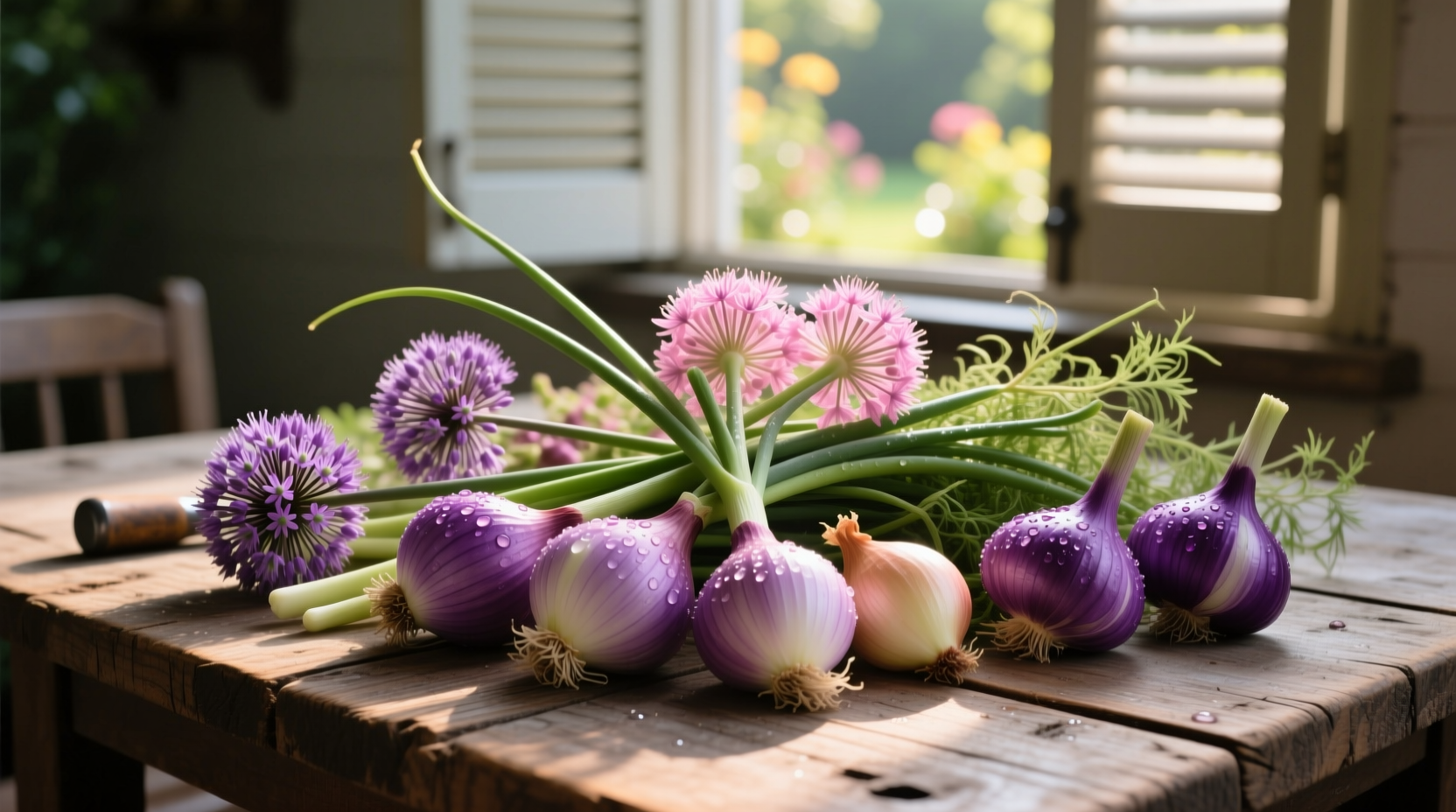When foraging or gardening, correctly identifying onion-like vegetables is essential for both culinary success and personal safety. Many plants resemble onions but contain toxic compounds that can cause severe illness. This guide provides practical identification techniques used by professional chefs and horticulturists to distinguish edible alliums from dangerous imposters.
Understanding Onion-Like Vegetables: The Critical First Step
The most reliable way to identify true edible alliums is the distinctive onion-garlic aroma when leaves or bulbs are crushed. This simple test separates safe-to-eat varieties from toxic look-alikes that lack this characteristic scent. According to the USDA Plants Database, all members of the Allium genus share this aromatic quality due to sulfur compounds.
| Plant Type | Crushed Leaf Smell | Bulb Characteristics | Safety Status |
|---|---|---|---|
| True Onions | Strong onion/garlic | Papery skin, layered | Edible |
| Wild Garlic | Garlic aroma | Single bulb, no layers | Edible |
| Death Camas | No distinctive smell | Fleshy, no papery skin | Poisonous |
| Bluebell | No onion smell | Clustered bulbs | Poisonous |
This identification method has evolved significantly over time. Historical foragers relied primarily on visual characteristics, which led to frequent misidentifications. The Royal Horticultural Society documents how modern identification protocols now emphasize sensory verification through smell testing as the primary safety measure.
Edible Onion Relatives: Culinary Treasures
Several allium varieties offer unique culinary properties while maintaining the characteristic onion aroma that confirms their safety:
- Shallots - Milder, sweeter flavor ideal for vinaigrettes and delicate sauces
- Scallions - Both white and green parts usable, perfect for quick cooking
- Leeks - Larger, milder cousin requiring thorough cleaning of layers
- Chives - Delicate onion flavor best used fresh as garnish
- Ramps - Wild allium with garlic notes, seasonal spring delicacy
Professional chefs like those at the James Beard Foundation recommend using different allium varieties according to their specific flavor profiles rather than treating them as simple substitutes. Each brings unique compounds that interact differently with other ingredients during cooking.

Dangerous Look-Alikes: Critical Safety Information
Several poisonous plants closely resemble edible alliums, particularly in early growth stages. The American Association of Poison Control Centers reports numerous annual cases of misidentification, especially involving death camas (Zigadenus venenosus) which grows in similar habitats as wild onions.
Context matters significantly when identifying these plants. Death camas bulbs become more difficult to distinguish from wild onions during late spring when both are flowering. The critical boundary condition is that all true alliums produce the characteristic onion smell when any part is crushed, while toxic look-alikes do not.
If accidental consumption occurs, immediate medical attention is necessary. Symptoms of poisoning from death camas include nausea, vomiting, and in severe cases, respiratory distress. The National Poison Control Center (1-800-222-1222) provides 24/7 guidance for potential plant poisonings.
Practical Identification Techniques for Home Cooks
Follow these professional chef-tested methods when working with unfamiliar onion-like plants:
- Smell test - Crush a small portion of leaf or bulb; true alliums produce immediate onion/garlic aroma
- Visual inspection - Check for papery bulb covering and layered structure
- Habitat assessment - Note growing conditions (many toxic look-alikes prefer wetter environments)
- Flower examination - Alliums produce spherical flower clusters; death camas has looser, greener blooms
- Consult multiple sources - Cross-reference with at least two authoritative plant identification guides
When foraging wild alliums, never consume plants growing near roadsides or potentially contaminated areas. The Cooperative Extension System recommends washing all foraged plants thoroughly and starting with small portions to check for individual sensitivities.
Maximizing Flavor in Your Cooking
Different allium varieties respond uniquely to cooking methods. Understanding these differences helps maximize flavor while maintaining safety:
- Raw applications: Use milder varieties like scallions and chives
- Sautéing: Shallots and onions develop complex sweetness at medium heat
- Roasting: Whole bulbs like pearl onions caramelize beautifully
- Pickling: Smaller varieties like pickling onions absorb flavors best
Remember that cutting technique affects flavor release. The University of California Division of Agriculture and Natural Resources explains that finer cuts increase surface area, releasing more flavor compounds but also causing faster degradation of beneficial compounds.
Frequently Asked Questions
Can I safely eat wild onions I find in my yard?
Only if you've positively identified them through the smell test and visual characteristics. Many toxic plants resemble wild onions, especially death camas. When in doubt, consult a local extension service before consumption.
What's the most reliable way to distinguish edible alliums from poisonous look-alikes?
The crushed leaf smell test is the most reliable method. True alliums produce an immediate onion or garlic aroma when any part is crushed, while toxic look-alikes like death camas have no distinctive smell or produce an unpleasant odor.
Are all parts of edible alliums safe to eat?
Yes, all parts of true alliums (onions, garlic, leeks, etc.) are edible, though some parts may be tougher than others. The green tops of scallions and chives are particularly flavorful, while the white bulb portions offer stronger flavor. Always remove any discolored or damaged sections.
How should I store fresh alliums to maximize shelf life?
Store most alliums in a cool, dark, well-ventilated place. Onions and garlic last longest (1-2 months) when kept in mesh bags away from potatoes. Scallions and leeks should be refrigerated with roots submerged in water, changing water every few days. Never store alliums in plastic bags which trap moisture and accelerate spoilage.











 浙公网安备
33010002000092号
浙公网安备
33010002000092号 浙B2-20120091-4
浙B2-20120091-4